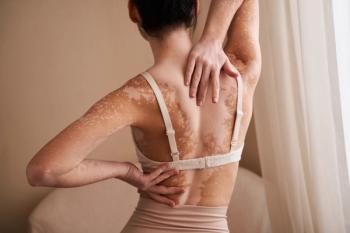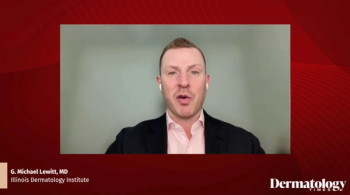
- Dermatology Times, January 2023 (Vol. 44. No. 01)
- Volume 44
- Issue 01
The Psychosocial Impact of Vitiligo
Vitiligo, an autoimmune skin condition that causes depigmentation, can have a large effect on a patient’s quality of life and psychosocial well-being.
Chronic skin diseases have been shown to affect a patient’s quality of life (QOL) on multiple dimensions due to the fact that these conditions are associated with social stigmatization. As a result, patients can suffer from low self-esteem, anxiety, or depression. Previous research conducted by Bhutani et al. demonstrated that patients with an untreated inflammatory skin disease can have as much impairment in psychological well-being as patients with other major medical disorders such as congestive heart failure, coronary artery disease, diabetes, and breast cancer.
Vitiligo, an autoimmune skin condition that causes depigmentation, is another skin condition that can have a large effect on a patient’s quality of life and psychosocial well-being. While vitiligo does not cause any physical issues, even mild disease can have a profound detrimental impact on quality of life.2 Specific skin conditions, such as vitiligo, may be associated with specific psychological signs and symptoms. It is important to be aware of these when treating and counseling patients given the disproportionate effect that vitiligo may have on a person’s well-being. Previous studies have shown that patients with vitiligo have a sense of disfigurement and disempowerment.3 These patients also feel a constant burden due to the unpredictability of the disease and the resulting need to conceal the disorder, either by makeup or clothing. In some Middle Eastern cultures, vitiligo was also noted to be a barrier to marriage.4 Due to the chronic nature of the disease, patients’ concerns focus on serious, lifelong potential relationships in many cases. This is especially pronounced when the disease begins in adulthood.
Depression is a serious comorbidity of vitiligo. The degree of depression has been found to be culturally specific and this variance is likely due to base skin color and cultural ideations of dyspigmented skin.5 For example, depression was shown to be more prevalent amongst Arabic patients as compared to Italian patients, and females were noted to be more affected than their male counterparts.3 Depression leading to suicidal ideation is the most feared morbidity of vitiligo. Suicidal ideation is particularly a concern amongst patients who cope poorly with their initial diagnosis and disease prognosis.6 A 2019 study found that patients with vitiligo in the United States had increased hospitalization for multiple mental health disorders including anxiety, depression, and suicide.7
Given the potential psychological morbidity associated with vitiligo, there have been efforts to create validated measures to track and assess the impact that this condition can have on a patient’s quality of life. The Vitiligo-Specific-Quality-of-Life Instrument (VitiQoL) was developed by Lilly et. al. using in-depth interviews with vitiligo patients and their responses to several other previously validated health-related quality of life measures.8 This instrument has been integral in studying vitiligo’s detrimental effects on mental health and has enabled researchers to understand them at a more granular level. For example, Morales-Sanchez et. al. demonstrated that vitiligo patients with genital lesions had a worse quality of life as compared to vitiligo patients without these lesions.9
Recent studies have focused on qualitative methods to study patients with vitiligo experiences and perceptions in a real-world scenario. Gadarwoski and colleagues used an interpretive research paradigm to assess public online forum content among patients with vitiligo. Major themes and subthemes discussed included vitiligo disease management, homeopathy/home remedies, psychosocial impact, public perceptions, and camouflage/concealment.10 Given the studies presented here, it is clear that vitiligo can have a large impact on a patient’s quality of life and mental health. To ensure complete care of the vitiligo patient, dermatology providers should always assess a vitiligo patient’s mental health and quality of life in addition to treating the skin disease itself.
References
1. Bhutani T, Patel T, Koo B, Nguyen T, Hong J, Koo J. A prospective, interventional assessment of psoriasis quality of life using a nonskin-specific validated instrument that allows comparison with other major medical conditions. J Am Acad Dermatol. 2013;69(2):e79-88. doi:10.1016/j.jaad.2012.10.009
2. Sampogna F, Tabolli S, Abeni D. Impact of different skin conditions on quality of life. G Ital Dermatol E Venereol Organo Uff Soc Ital Dermatol E Sifilogr. 2013;148(3):255-261.
3. Nguyen CM, Beroukhim K, Danesh MJ, Babikian A, Koo J, Leon A. The psychosocial impact of acne, vitiligo, and psoriasis: a review. Clin Cosmet Investig Dermatol. 2016;9:383-392. doi:10.2147/CCID.S76088
4. Thompson AR, Clarke SA, Newell RJ, Gawkrodger DJ, Appearance Research Collaboration (ARC). Vitiligo linked to stigmatization in British South Asian women: a qualitative study of the experiences of living with vitiligo. Br J Dermatol. 2010;163(3):481-486. doi:10.1111/j.1365-2133.2010.09828.x
5. Alghamdi KM, Moussa NA, Mandil A, et al. Public perceptions and attitudes toward vitiligo. J Cutan Med Surg. 2012;16(5):334-340. doi:10.1177/120347541201600510
6. Pahwa P, Mehta M, Khaitan BK, Sharma VK, Ramam M. The psychosocial impact of vitiligo in Indian patients. Indian J Dermatol Venereol Leprol. 2013;79(5):679-685. doi:10.4103/0378-6323.116737
7. Patel KR, Singam V, Rastogi S, Lee HH, Silverberg NB, Silverberg JI. Association of vitiligo with hospitalization for mental health disorders in US adults. J Eur Acad Dermatol Venereol JEADV. 2019;33(1):191-197. doi:10.1111/jdv.15255
8. Lilly E, Lu PD, Borovicka JH, et al. Development and validation of a vitiligo-specific quality-of-life instrument (VitiQoL). J Am Acad Dermatol. 2013;69(1):e11-18. doi:10.1016/j.jaad.2012.01.038
9. Morales-Sánchez MA, Vargas-Salinas M, Peralta-Pedrero ML, Olguín-García MG, Jurado-Santa Cruz F. Impact of Vitiligo on Quality of Life. Actas Dermosifiliogr. 2017;108(7):637-642. doi:10.1016/j.ad.2017.03.007
10. Gadarowski MB, Bashyam AM, McMichael AJ, Feldman SR. Views and Beliefs of Vitiligo Patients in Online Discussion Forums: A Qualitative Study. Cutis. 2022;109(1):49-53. doi:10.12788/cutis.0432
Articles in this issue
almost 3 years ago
Management of Generalized Pustular Psoriasisalmost 3 years ago
Say No to Nasal Tanning Spraysalmost 3 years ago
Nutritional Supplements to Treat Hair Lossalmost 3 years ago
Exploring the Connection Between IBD and Psoriasisalmost 3 years ago
Vitiligo Treatment and Managementalmost 3 years ago
Study Finds JAK Inhibitors Safer Than Other Systemic Agentsalmost 3 years ago
Dermatology Drug Pipeline 2023almost 3 years ago
5 Simple Financial Tips for Dermatologists and Their Practicesalmost 3 years ago
Nail Problems? Easy Solutionsalmost 3 years ago
I Used a New Dermal Filler: How Can This Get Me Arrested for Battery?Newsletter
Like what you’re reading? Subscribe to Dermatology Times for weekly updates on therapies, innovations, and real-world practice tips.

















